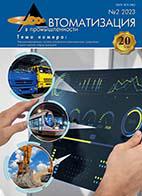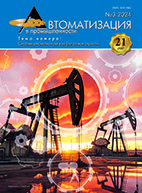Один опыт я ставлю выше, чем тысячу мнений, рожденных только воображением.М.В. Ломоносов

#2 2023
CONTENTS №2
Faruntsev S.D. From digital twin to intelligent control systems. Synthesis of a hybrid control model for thermal facilities of crude oil heating units
The paper suggests to examine and update the role of digital twin concept in the design monitoring, on-line diagnosis, and intelligent control of thermal facilities of crude oil heating units at oil and gas fields. The synthesis of a hybrid analytical and experimental model is offered as the basic digital twin design method. The methodology of development and identification of static and dynamic model parameters of thermal facilities with the help of network modeling is described. With the example of PP1,6 industrial crude emulsion heater, the paper describes the methods for model development, parameter identification, and advanced process control design with the help of pulse-duration modulation of the control signal.
Keywords: digital twin, hybrid model, thermal control objects, network mathematical model, crude emulsion heater, advanced process control system, artificial neural network, pulse-duration modulation.
Ivanovsky A.N., Cherny S.G. The features of hardware implementation of a draft survey control system
Draft survey (the estimation of the weight of cargo on a ship) is traditionally done manually based on the measurements of changes in the ship’s displacement. The procedure features low accuracy, and the measurement results cannot be verified after the lapse of time. To overcome this challenge, the concept of a draft survey control system was developed on the basis of machine vision algorithms. Application of U-Net and YOLO neural network architectures for the recognition of waterline and draft mark along with a set of machine vision algorithms for merging neural network operation results ensures high-precision draft evaluation and with substantial associated benefits. The paper discusses implementation features of such system subject to the experience gained during the testing of its elements on real-life ships.
Keywords: machine vision, deep learning, draft survey, cargo operations, safety automation.
Discussing a Topic…
Automated systems for vehicles and transport infrastructure
Shurupov A.V., Baryshev L.M. An overview of thr Russian market of traffic stream modeling software
The paper highlights the importance of traffic stream modeling in town planning tasks. It examines three classes of models describing traffic and passenger streams at macro, meso, and micro levels. The requirements to the architecture and functionality of the present-day transport modeling software are formulated. Commercial software available at the Russian market is reviewed. A digital transport behavior modeling platform, which is currently under development in Russia, is presented.
Keywords: traffic stream modeling, macro-, meso, and micro modeling, integration, information security, critical infrastructure.
Vil’danov A.G., Demyanov D.N. Automation of vibration survival testing of KAMAZ trucks
A procedure for vibration survival testing of trucks is offered. Its featured property is the reduced number of road tests owing to the application of a custom hard-/software complex, which includes a multifunctional testbench and the RPC PRO applied software. A case study of estimating the service life of the suspension of KAMAZ truck’s driver cab is included.
Keywords: truck, vibration survival, testing, automation, multifunctional testbench.
Meshcheryakov A.G., Letopolsky A.B., Nikolaev D.I., Teterina I.A. Digital technologies of automated data acquisition from excavator operation process
The paper investigates reference signals and control impacts made by human operator in the excavator control system. A hard-/software system for the acquisition and processing of digital data about the operation process of a single-bucket hydraulic excavator is developed. An outlook of data analysis development is included.
Keywords: digital data, automated data acquisition, excavator, control system.
Jabrailov Kh.A., Yakhimovich M.E., Gematudinov R.A., Tarasova A.V., Selezneva P.A. Investigation of the efficiency of roadbed defect detection with neural network-based data processing
The applicability of U-Net neural networks to roadbed defect banding is examined. The objective is to compare the efficiency of U-Net against the Attention Gate (AG) technique as well as to investigate the influence of the loss function on the banding quality. The paper presents the quantitative result of neural network operation on subject-oriented data and, finally, concludes about the use of neural networks in this application field.
Keywords: neural network, efficiency estimate, roadbed defects, loss function, network learning.
Novikov I.A., Strumitsky M.V. Automated pre-trip inspection system: a solution which prevents errors
A domestic software product for intelligent monitoring of psycho-emotional, and physiological state of an individual is presented. The product is used by many major transport companies, such as Gorelectrotrans SUE, for ensuring passenger transportation safety.
Keywords: automated pre-trip inspection system, psycho-emotional, and physiological state of an individual, transport.
Gorbachev A.M., Vasilenko P.A. Modern trends in the development of automated control systems for urban transport
Problems and approaches to automating the planning and control of urban transport, as well as directions for the development of automated control systems for the movement of route transport are considered. The structure of the software package for managing urban electric transport, designed to automate the planning and control of urban transport, including for the tasks of scheduling, compiling release orders, generating waybills, group notification of the driver about events on the line, communication "dispatcher-driver" and monitoring of transport, as well as for maintaining a database of incidents.
Keywords: urban transport, traffic organization, route schedule, dispatching.
Semenova E.G., Smirnova M.S., Ivakin Ya.A. Application of deep neural networks for classifying the objects detected by hydroacoustic tools
The classification of the objects detected by hydroacoustic tools (circuit, station, complex, etc.) is a complicated and knowledge-intensive task in respect to its algorithmic implementation. Active improvement of neural network technologies, in particular, the ones based on deep neural networks, enables the development of a novel technological framework for effective classification. The paper analyzes the ways for applying neural network solutions in the classification of an object detected by a hydroacoustic tool during the search.
Keywords: deep neural network, hydroacoustic complex, neural network solutions.
Murzagulov D.A., Zamyatin A.V., Karev S.V. Software for process signal anomaly identification
Fundamental modernization of process controls results first and foremost in the extension of analytical software tools. Analytical functions are currently available in certain system classes; also, new conceptual approaches to industrial data analysis are known. The paper offers an approach to the design of software applications for a modular system of process signal anomality identification. The approach allows for signal features, the details of mathematical algorithms, and the possibility of integration into industrial systems.
Keywords: process control, anomaly identification, process signals, software.
Bogatyrev V.V., Levitsky A.V., Nikolaev P.M., Nikulenko A.A., Shardin A.O., Yustus A.A. Comparative tests for aerodynamic profiles with reference to the investigation of aircraft parts icing process
The paper discusses the investigation on the selection of optimal tests for comparing the aerofoils of aircraft parts against the database of aerofoils with ice forms preprepared in wind-tunnel and air flight experiments under various icing conditions.
Keywords: icing, experimental investigation, design, wing, aerofoil, mathematical model.
Koloshkina I.V. Education of specialists for automatic development of technologies and software for NC machinery
The paper informs about the educational structure for specialists in the field automatic development of technologies and software for NC machinery. The structure was developed and implemented in the system of higher education. The information about the industrial software selected subject to import replacement is included. Control programs developed in the CAM system can be verified both on the real-life equipment and on computer simulators; possible variants are discussed.
Keywords: computer-aided design, NC machining, NC machinery programming, specialist training, computer simulation.
Pleshakov F.A., Zmeu K.V., Morozova N.T. Experimental facility for sand mixture placement for automatic development of casting molds
The experimental unit for automatic development of casting molds with the help of additive technologies is presented. Sand mixture placement techniques are described. The control system was developed for an experimental device comprised of a screw conveyor and a slide valve. The experimental unit developed is aimed at the investigation of the technology of layered sand mixture placement.
Keywords: additive technologies, casting mold, 3D printing, sand mixture, experimental facility, slide valve, screw conveyor.
Последний вышедший номер
Адрес редакции: 117997, Москва, Профсоюзная ул., д. 65, оф. 360
Телефон: (926) 212-60-97.
E-mail: info@avtprom.ru или avtprom@ipu.ru
© ООО Издательский дом "ИнфоАвтоматизация", 2003-2024 гг.
